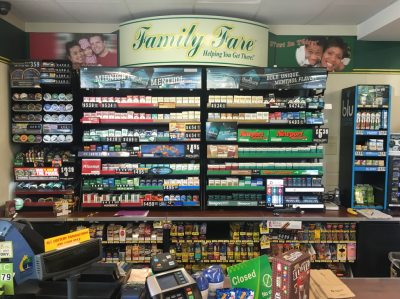With $11.6M NIH grant, researchers will study retail tobacco policies across the U.S.
September 19, 2018
Researchers at the University of North Carolina at Chapel Hill, Stanford University and Washington University in St. Louis have received a five-year, $11.6 million National Institutes of Health (NIH) grant to study retail tobacco policies across the United States.
Tobacco use causes nearly a half million premature deaths each year from cancer, cardiovascular disease and pulmonary illnesses. Most tobacco is purchased from brick-and-mortar retailers, where the tobacco industry spends $1 million every hour on advertising and marketing.

Tobacco products line the shelves at a typical small retail store.
The 2009 Family Smoking Prevention and Tobacco Control Act gave states and localities more authority to regulate the sales and distribution of tobacco products in their communities. The rapid growth and spread of policies and interventions in the tobacco retail setting in the past nine years calls for systematic research to evaluate the efforts.
Researchers at the three universities will join together to form Advancing Science & Practice in the Retail Environment (ASPiRE). The project’s goal is to build a strong scientific evidence base for effective policies in the retail environment to help reduce tobacco use, tobacco-related disparities and the public health burden of tobacco, including cancer.
Three innovative and complementary research projects will examine the role of the tobacco retail environment in promoting tobacco use and causing tobacco-related illnesses. Researchers will study how tobacco retailer density contributes to cigarette smoking and tobacco-related illnesses, evaluate the impact of local retail interventions on tobacco use and availability, and develop computational models to learn how changes in the built and consumer environment could lead to improved public health.
A Community Advisory Board, whose members include tobacco control leaders from 30 large U.S. cities and organizations such as the Campaign for Tobacco-Free Kids, will give input and guidance on what is most needed in their communities.
The principal investigators for ASPiRE are Kurt M. Ribisl, PhD, chair and professor in the Department of Health Behavior at the UNC Gillings School of Global Public Health and program leader for Cancer Prevention and Control at the UNC Lineberger Comprehensive Cancer Center; Lisa Henriksen, PhD, senior research scientist at the Stanford Prevention Research Center in Palo Alto, Calif., and a member of the Stanford Cancer Institute; and Douglas A. Luke, PhD, professor of public health at the Brown School at Washington University in St. Louis, Mo., and director of the Center for Public Health Systems Science.
The ASPiRE group is continuing a “team science” approach built on a strong, multidisciplinary six-year collaboration that began in 2012 with funding from the National Cancer Institute’s State & Community Tobacco Control Initiative.
“I am thrilled to be part of this dream team of scientists who will study how the retail environment affects tobacco use and identify promising solutions for communities,” said Ribisl. “Our center brings expertise in behavioral science, epidemiology, public policy and computational modeling. Retail is one of the hottest areas in tobacco control and we are eager to expand the evidence base in this important area.”
Does higher retailer density lead to more disease?

Dr. Kurt Ribisl
In the Density and Disease project, which Ribisl will lead, UNC researchers will map 275,000 tobacco retailers across the U.S. from 2000 to 2016 and explore the relationship between the density of these retailers and tobacco-related illnesses, like cancer.
“This will be a landmark study because it will finally sort out the relationship between the density of tobacco retailers, smoking prevalence and disease,” Ribisl said. “In areas with more tobacco retailers, do we eventually see higher smoking rates and higher cancer rates? We will examine nearly 15 years of data to figure that out. This is important because communities are starting to enact policies to reduce the number of tobacco retailers, and it is essential to understand whether that will reduce smoking rates as well as cancer and heart disease.”
Shelley Golden, PhD, assistant professor of health behavior at the UNC Gillings School, will co-lead the Density and Disease project with Ribisl. Project co-investigators linked with the Gillings School are Christopher Baggett, PhD, assistant professor of epidemiology and faculty director of the Cancer Information & Population Health Resource at UNC Lineberger; David Richardson, PhD, associate professor of epidemiology; and alumnus Joseph Lee, PhD, now an assistant professor of health education and promotion at Eastern Carolina University. Additional supporting personnel from UNC Gillings and/or UNC Lineberger are analysts Tara Queen, PhD, May Kuo, PhD, and Cearo Faulk; assistant project director Sara Vandegrift; postdoctoral fellow Sarah Mills, PhD; and graduate students Amanda Kong, MPH, Vivian Tao and Rakiah Anderson.
How does the retail environment affect quit attempts?

Dr. Lisa Henriksen
The Stanford-led project, Big City Tobacco Control, will seek to understand how the tobacco retail environment in a city may impede efforts at quitting smoking. This study also will evaluate the benefits of local policies to regulate and limit retail availability of tobacco. Stanford researchers will survey a panel of 2,400 adult smokers five times over 30 months and will examine changes in over time.
“This is a collaborative effort with local tobacco control programs in 30 large cities,” said project lead Henriksen. “Together, the selected cities are home to one in six U.S. residents. Our partners at the Public Health Law Center in Minnesota and the Truth Initiative in Washington, D.C., will help us document how local policies change over time and enable us to study policy impact on retail availability and tobacco use, particularly use of menthol and other flavored products in lower-income neighborhoods.”
Can retail policies impact tobacco user behaviors?

Dr. Douglas Luke
Researchers at Washington University in St. Louis will lead the Tobacco Town project, which will use agent-based modeling to study innovative policies in the retail setting and calculate their impact in different types of communities, especially those with low-income and minority populations. Data collected from the Big City Tobacco Control project will help inform model development for Tobacco Town by adding current and realistic tobacco use patterns and user behaviors.
“The Tobacco Town study is exciting, because the computational models will be used to better understand how retail policies actually operate to improve community health,” said Luke, the project lead. “In turn, communities will learn how to tailor these policies to meet their particular tobacco control needs.”
In addition to these three collaborative research projects, the ASPiRE Center has three shared resource cores that will provide administrative, data and statistics, and dissemination and implementation support to extend the reach of the findings and improve synergy among all the projects.
This research is supported by the National Institutes of Health under Award Number P01CA225597. The content is solely the responsibility of the authors and does not necessarily represent the official views of the National Institutes of Health.
Contact the Gillings School of Global Public Health communications team at sphcomm@listserv.unc.edu.
